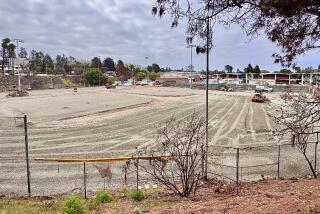Reopening Delayed for 2 Tainted Schools
- Share via
Two Los Angeles high schools that were closed after cancer-causing asbestos was discovered dislodged by construction work will probably not reopen until Friday, officials said Monday.
Though the cleanup should be done by today, school officials are delaying the reopening of Palisades Charter High School on the Westside and Roosevelt High School on the Eastside so that a team of regulatory agencies and health risk experts assembled Monday can certify that the schools are safe.
Also on Monday, Lynn Roberts, head of the district’s facilities division, said she notified eight contractors that they are being investigated in connection with the asbestos releases discovered at nine schools, and that if any are found negligent, they will be suspended or barred from district work.
At seven of those schools, the hazardous material was found only in one or two rooms, allowing abatement teams to remove it without disrupting classes. District officials decided to close Palisades on Friday and Roosevelt on Monday because the cleanup would have displaced more students than the remainder of the campuses could accommodate. The lost days will be made up later in the school year.
Although a member of the district’s environmental safety team had predicted suspensions would occur early this week, Roberts said it was not yet clear that any of the contractors were at fault.
But at a parents meeting Monday, Angelo Bellomo, a member of the safety team, blamed the facilities division as well as the contractors.
Bellomo said the errors resulted partly from prior policy that made facilities, rather than the environmental health and safety branch, responsible for overseeing work involving asbestos-containing materials.
“They didn’t do their job, or this wouldn’t have happened,” he said.
Safety officials who met with parents for the first time Monday tried to calm their fears by characterizing the risk to students as very low.
William Panos, the new head of the district’s environmental health and safety branch, said the contamination at Palisades involved 32 classrooms where workers sawed into ceiling wallboard that contains small amounts of asbestos.
The workers failed to clean up construction dust and, in some cases, students and faculty swept it up. Some of the dust was still visible when inspectors checked the classrooms last week, officials said.
Students were probably exposed to the dust about two months before the classrooms were shut down and sealed, Panos said. But he said the exposure was slight because the concentration of asbestos in the dust was less than 1%, a level that many states do not consider significant enough to regulate.
Michael Lakin, a toxicologist who will serve on the district’s certification team, said he would have no concern about sending his own children to Palisades.
“I haven’t seen anything that would make me say, ‘Oh, my God, this is a major problem,’ ” Lakin said.
Facing a flurry of agitated questions about what parents should tell their doctors, Panos provoked gasps when he said safety workers had cleaned up the classrooms before taking any measurements of airborne asbestos, which can become lodged in the lungs and cause cancer.
Panos said the classrooms were sealed and cleaned, and only then were samples taken.
Lakin, the toxicologist, said it would not have served any purpose to take air samples first, because asbestos in the air dissipates and settles.
A sample from last week would not have given an accurate indication of the exposure over the entire two months, he said.
District officials said they still are conducting laboratory analyses needed to provide useful information to doctors. They will take into account the type of asbestos, the percentage of it in the wallboard, the length the cuts and the time of exposure.
Shobha Naimpally, a doctor with the district’s student medical services, advised parents against seeking X-rays, because the medical effects of asbestos take 10 to 45 years to develop, and instances of asbestos-related illness are rare in children.
Parents Dean and Barbara Melnick, who said their son has experienced nightmares since the school closed, said they appreciated the information, incomplete as it was.
“We feel much better,” Dean Melnick said.
Bellomo said he has tried not to overstate or understate the risks.
The decision to close two schools marks a sharp departure from prior policy, as documented by an investigator’s report in September.
Keith Rohman, hired in response to criticisms of the environmental health and safety branch, concluded in that report that the long-standing practice of covering up health risks makes it impossible to know with any certainty whether any school is safe.
“There is an unwritten policy in the district, you do not close a school for any environmental problem,” investigator Keith Rohman quoted one district health specialist as saying. “It looks bad if you close a school and find nothing. It looks bad if you do find something. You never make students go home.”
More to Read
Sign up for Essential California
The most important California stories and recommendations in your inbox every morning.
You may occasionally receive promotional content from the Los Angeles Times.














